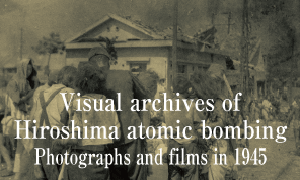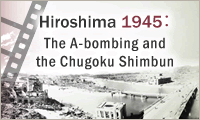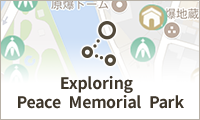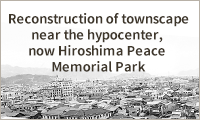Seedling grown from A-bomb survivor tree takes root overseas
May 16, 2014
Tended by students in Singapore
Helps cultivate anti-nuclear sentiment
by Yumi Kanazaki, Staff Writer
A seedling grown from a camphor tree that survived the atomic bombing of Hiroshima has been planted on the campus of the National University of Singapore (NUS). The university received the seed for the tree from Green Legacy Hiroshima (GLH), a group that distributes seeds and seedlings from A-bomb survivor trees. Students at the university germinated the seed and raised the seedling. A ceremony was held on the campus to mark the planting of the tree. Those involved in the project hope that the tree will take root and become a symbol of peace and friendship.
Among those at the ceremony was Shinichi Ue, a professor at Hiroshima University who is active in GLH. As the students looked on, Prof. Ue and others shoveled dirt around the leafy seedling. Camphor trees readily adapt to hot, humid climates, and the tree is likely to grow faster than it would in Japan.
Tommy Koh, rector of Tembusu College, is friends with Nassrine Azimi, one of the coordinators of GLH, and this provided the impetus for the project. In June 2012, the group received 30 seeds, and they succeeded in germinating several of them. Eight student volunteers carefully tended the seedlings. The Singapore Botanic Gardens cooperated in the effort, allowing the students to keep the pots there and offering advice on cultivation.
In December 2012, Sarah Wee, 22, a sophomore, came to Hiroshima on a homestay in order to study Japanese. At that time she went to see the tree from which the seeds had been taken. The tree is beside a moat on the grounds of Hiroshima Castle, about 1.1 km from the hypocenter of the A-bombing. Ms. Wee also met with a tree doctor and learned about cultivation. She was so impressed by the tree’s ability to survive the A-bombing that she changed her major from psychology to life science.
She said caring for the seedlings from Hiroshima was challenging as she had no prior experience in gardening or botany. “This project also taught me about the complexity behind caring for plants, reinforced my stand against nuclear weapons and prompted me to be more interested in Japan,” she said.
Margaret Tan, 43, a fellow at Tembusu College, coordinated the students’ efforts. She noted that Singapore was occupied by the Imperial Japanese Army during World War II, and Singaporeans do not all share the same view on the atomic bombing. Nevertheless she said she felt the GLH project provided a good opportunity to learn about the suffering that the atomic bombing caused. She also remarked on the significance of the project, saying that the students had learned the importance of peace, friendship and environmental conservation by tending the seedlings. She said the students will continue to cultivate more seedlings.
GLH, a volunteer initiative, was established by Tomoko Watanabe and Nassrine Azimi in July 2011 and is supported by the Hiroshima Office of the United Nations Institute for Training and Research and ANT-Hiroshima, a non-profit organization, as well as the City of Hiroshima and the Hiroshima Botanical Garden, among others.
(Originally published on May 12, 2014)
Helps cultivate anti-nuclear sentiment
by Yumi Kanazaki, Staff Writer
A seedling grown from a camphor tree that survived the atomic bombing of Hiroshima has been planted on the campus of the National University of Singapore (NUS). The university received the seed for the tree from Green Legacy Hiroshima (GLH), a group that distributes seeds and seedlings from A-bomb survivor trees. Students at the university germinated the seed and raised the seedling. A ceremony was held on the campus to mark the planting of the tree. Those involved in the project hope that the tree will take root and become a symbol of peace and friendship.
Among those at the ceremony was Shinichi Ue, a professor at Hiroshima University who is active in GLH. As the students looked on, Prof. Ue and others shoveled dirt around the leafy seedling. Camphor trees readily adapt to hot, humid climates, and the tree is likely to grow faster than it would in Japan.
Tommy Koh, rector of Tembusu College, is friends with Nassrine Azimi, one of the coordinators of GLH, and this provided the impetus for the project. In June 2012, the group received 30 seeds, and they succeeded in germinating several of them. Eight student volunteers carefully tended the seedlings. The Singapore Botanic Gardens cooperated in the effort, allowing the students to keep the pots there and offering advice on cultivation.
In December 2012, Sarah Wee, 22, a sophomore, came to Hiroshima on a homestay in order to study Japanese. At that time she went to see the tree from which the seeds had been taken. The tree is beside a moat on the grounds of Hiroshima Castle, about 1.1 km from the hypocenter of the A-bombing. Ms. Wee also met with a tree doctor and learned about cultivation. She was so impressed by the tree’s ability to survive the A-bombing that she changed her major from psychology to life science.
She said caring for the seedlings from Hiroshima was challenging as she had no prior experience in gardening or botany. “This project also taught me about the complexity behind caring for plants, reinforced my stand against nuclear weapons and prompted me to be more interested in Japan,” she said.
Margaret Tan, 43, a fellow at Tembusu College, coordinated the students’ efforts. She noted that Singapore was occupied by the Imperial Japanese Army during World War II, and Singaporeans do not all share the same view on the atomic bombing. Nevertheless she said she felt the GLH project provided a good opportunity to learn about the suffering that the atomic bombing caused. She also remarked on the significance of the project, saying that the students had learned the importance of peace, friendship and environmental conservation by tending the seedlings. She said the students will continue to cultivate more seedlings.
GLH, a volunteer initiative, was established by Tomoko Watanabe and Nassrine Azimi in July 2011 and is supported by the Hiroshima Office of the United Nations Institute for Training and Research and ANT-Hiroshima, a non-profit organization, as well as the City of Hiroshima and the Hiroshima Botanical Garden, among others.
(Originally published on May 12, 2014)










